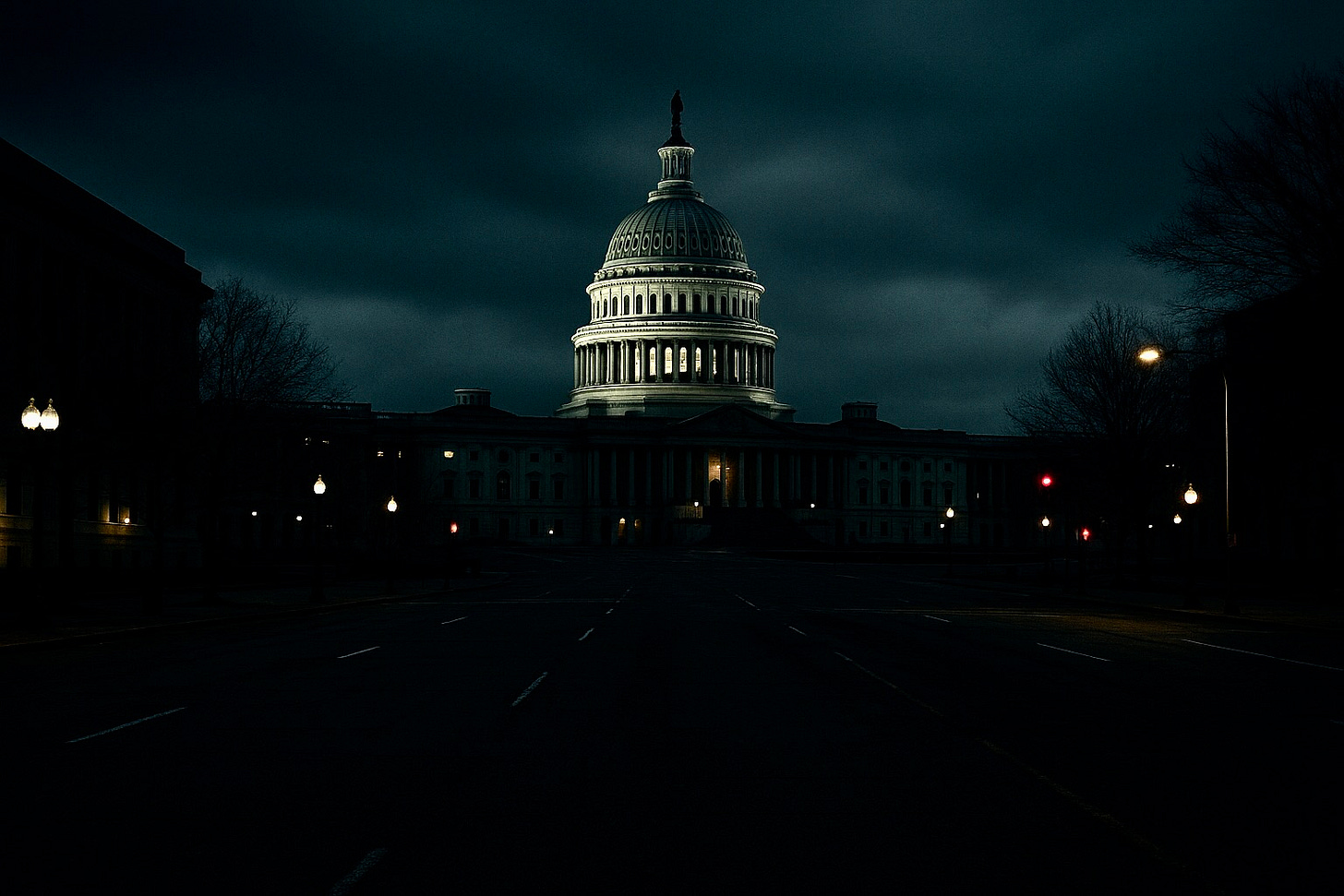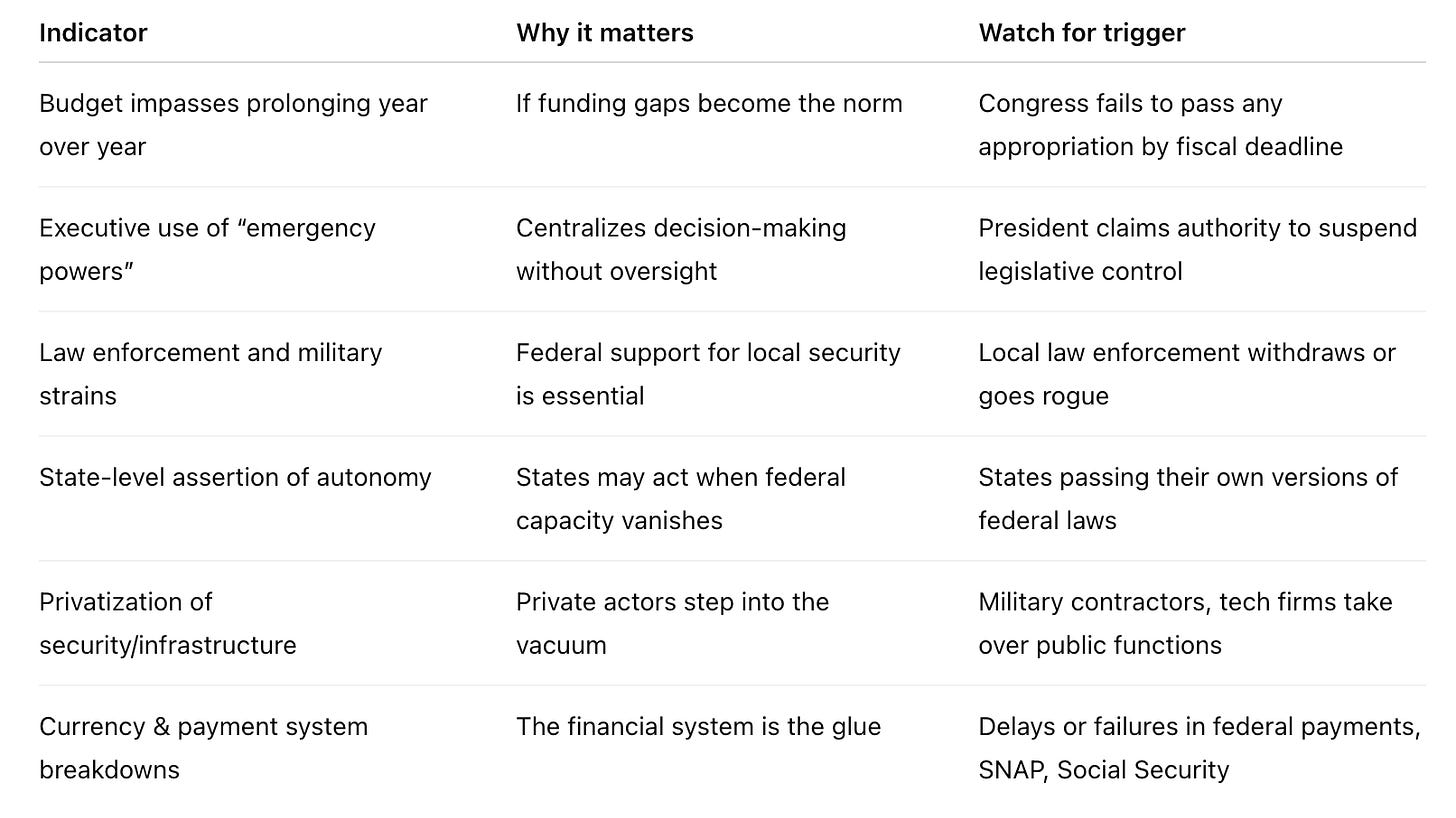I want you to imagine: Washington DC, October 6, 2029. The federal government has effectively shut down — not for a few weeks, but for good.
I saw it through the eyes of two people. Let’s call one Ava, a midlevel analyst in the Department of Infrastructure, reassigned to “continuity planning” when the first waves of furloughs hit. And we’ll call the other one David, a Washington journalist trying to track what remains.
Trigger
The crisis began as a budget standoff turned existential. Congress failed to pass any appropriation or continuing resolution for the 2030 fiscal year. The president invoked a rarely used “emergency shutdown” clause, ordering federal agencies to run at 50 percent capacity, and rotating closures every two weeks to stretch dwindling funds.
Employees were told they couldn’t count on regular paychecks. “Essential” services would keep going, but lines would slow down. Permits, taxes, subsidies — some would vanish. Local governments were told to pick up the slack, as if they had the means to do so.
Ava’s unit in Infrastructure was ordered to suspend all new projects except those deemed “crisis-level.” Maintenance work slowed down. Bridges, dams, roads — inspections were deferred.
David’s press pass became almost useless. Many agencies closed their press offices. Some spokespeople vanished. He found himself dealing with ghost departments. And absolutely no way to justify his salary.
The stakes were immediate: federal workers missed paychecks. Critical services fell apart. Public trust evaporated to low levels that would have shocked people back in 2025.
Conflict
One morning, Oakland’s water treatment plant took a leak. The EPA branch responsible for oversight had shut down for two weeks. The city scrambled. Contamination warnings went out. Panic bubbled in the dirty, dangerous water.
In New York State, federal funding for disaster relief dried up just as a storm surge hit. FEMA offices were furloughed; state and city agencies rushed in but lacked capacity. A few counties simply declared a “local emergency” and hoarded supplies.
In several midwestern towns, local law enforcement that had partnered with federal agencies — for forensics, cybercrime, and border coordination — saw those links break. Violent crime surged in some areas. Gangs staked out neighborhoods. In others, vigilante militias formed, arguing the federal collapse meant “you take care of yourself.”
For some Christian nationalist militias, it was a dream come true — a prophecy fulfilled. There was no longer anyone to stop them from beating up or killing anyone who was the wrong religion or skin color. No one to disabuse them of the notion that they had a right to kill any unlucky LGBTQ person they came across.
Protests erupted outside IRS field offices, Social Security offices, and VA hospitals. People demanded their pay, their benefits, their government back. They were getting desperate, and in many places the veneer of civilized, peaceful protest shattered. Some city halls became temporary relief centers. Food banks filled but then emptied too fast. Supply chains hiccupped when inspections at ports slowed under reduced Customs staffing.
State governments tried to assert authority. Governors declared states of emergency and allocated reserve funds to sustain essential services. But their coffers drained fast.
Yeats was right. The center did not hold.
Who Takes Over?
Behind closed doors, alliances formed. A consortium of tech magnates, financial titans, and former generals quietly talked about “stabilizing the realm.” With Congress deadlocked, they whispered about privatized security, privatized infrastructure, and private currency networks. They funded paramilitary units under shell nonprofits. They offered to “restore order” — for a price. Meanwhile, they thought they were safe in fortified buildings and bunkers. They didn’t have to see the people they didn’t care about.
The president declared that some protestors were “rebels” and authorized military intervention under federal emergency powers. National Guard units mobilized, but many state governors resisted federal calls if the money wasn’t flowing. In some states, guards refused orders, citing chain-of-command collapse.
As military budgets dried up, parts of the armed forces fractured. Some units were loyal to regional commanders, some to federal command, others to private contractors. Logistics collapsed; supply lines were cut. Fuel, munitions, maintenance — all squeezed to a trickle. Soldiers found themselves unable to defend against angry civilians. They were made to pay for the massive military budgets that had taken food out of the mouths of babes over the last 90 years.
Some soldiers were smart enough to see where things were going and ditched their uniforms, trying to blend into the mob.
California, with its economic power — once again the fourth-largest economy in the world — declared it would operate “in autonomous mode” until a path forward was found. It petitioned its own treasury to take over federal functions within state lines: taxation, infrastructure, and public health. Washington and Oregon expressed interest. But California’s finance office quietly warned: “We can’t absorb twenty-plus million more people beyond our means.” The California National Guard deployed to state borders to make sure everyone else understood that there was no room in the life raft.
Some states opted to form loose confederations; others fractured into local fiefdoms. The federal government, once a unifying structure, dwindled to the domain of oligarchs and security contractors who held capital and arms, shrinking in on themselves.
The End
In the final snapshot, Ava monitors the collapse of the national grid’s oversight. She writes a memo she knows no one will read: the union of states has fractured beyond repair. The United States persists in name only — a hollow shell, its functions run by private firms, warlords, and regional governors.
David writes a column in his fading digital publication: “We watched it die.” He traces how citizens in some cities moved to barter economies and local currencies. Some communities formed new assemblies. Others fell under gang rule. The empire is gone; an oligarchy remains.
And there was no one to write a history. All media and communication were in the hands of the oligarchs. Any history of the collapse that was written was not published in the former United States. The people who used to call themselves Americans would never know the full story of what happened.
Epilogue: 2040 — A Post-American World
Ten years later, there is no U.S. government in the old sense. What remains is a patchwork: the Republic of California; the Northern Confederation (Oregon, Washington, parts of Idaho and Montana); fragmented “free cities” in the former South; the Eastern Consortium along the old I-95; and a few militarized zones controlled by corporate powers.
Outside powers quietly pick off what’s left — ports, minerals, defense contracts. The concept of “national defense” is sold to the highest bidder.
How Real Is This Scenario?
The record for the longest U.S. federal shutdown is 35 days (December 2018 – January 2019).
We’re a long way from a permanent shutdown — but some warning signs merit watching. Below are pressure points and how they might crack.
This scenario is unlikely in full, but not impossible in parts. The federal structure is still in place for now, but vulnerabilities grow under repeated strain. The question isn’t if pressures emerge — it’s which ones break first.
The Soviet political scientist Igor Panarin once predicted America’s collapse into six regions. He thought it would happen by 2010. Maybe he was just off by a few years. Maybe the trigger won’t be war — it will be apathy… and a government shutdown that spirals into a meltdown.




